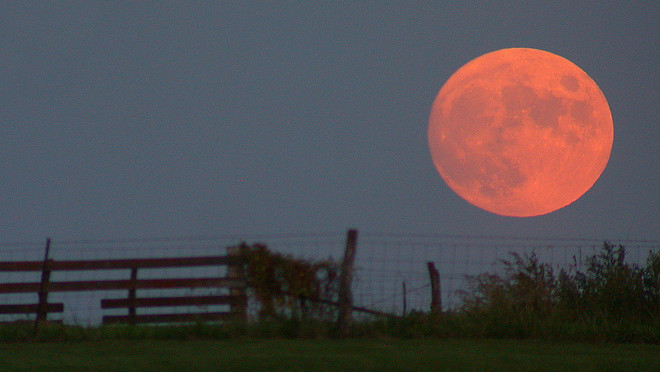Eclipse of the Harvest Moon
- Share
- Tweet
- Pin
- Share

The Door Peninsula Astronomical Society (DPAS) has chosen the “Eclipse of the Harvest Moon” as the theme for Astronomy Evening 2015. The evening of the full moon, indoor activities will begin at 7:30 pm at the Astronomy Campus of Crossroads at Big Creek, 2200 Utah St. Viewing of the Lunar Eclipse will begin around 8 pm, a remarkably reasonable hour for an astronomical event.
Members of DPAS have a love/hate relationship with the moon. Of course, we love our moon. It’s gorgeous, especially the Harvest Moon in early fall. It is the first celestial object any of us knew by name. And we all cheerfully acknowledge that life as we know it would not be possible without the gravitational pull of our moon.
But as Mike Lynch, author of Wisconsin Starwatch, wrote: “The moon is the enemy of stargazing, especially when it is full. The moon’s evil light washes out all but the brightest stars and constellations. You can’t go skating in a buffalo herd, and you can’t stargaze under a full moon!”
Every fall, the DPAS Board grapples with selecting a date for the annual “Astronomy Day/Evening” outreach event. In Door County, avoiding football, fall festivals and full moons is not easy. But this year, the Harvest Moon, Supermoon and Blood Moon all happen on a Sunday, a week the Packers play on a Monday night. Clearly (and we do hope the sky is clear), Astronomy Evening on Sept. 27 was meant to be.
So what is a Supermoon? That just means the moon is closer to Earth than usual. That can influence the ocean tides, but really, any full moon will look big when it is near the horizon and not so big when it is higher in the sky. Don’t expect some giant vision.
The Harvest Moon is just the full moon closest to the Autumnal Equinox. And that’s probably how it got its name. In most parts of the United States and Europe, autumn is the time of harvest. Our agrarian ancestors took advantage of the bright moon, which came up shortly after sundown because it enabled them to stay out in the fields longer.
The Blood Moon is simply another name for a lunar eclipse. Lynch explains, “During a lunar eclipse, the moon doesn’t go dark. Instead, it goes red from filtered sunshine making its way through the surrounding shell of the earth’s atmosphere…the red light we see on the moon is actually the combined twilight of all the sunrises and sunsets happening on earth during the time of the eclipse.”
Astronomy Evening will start at 7:30 pm with moon-related activities in the Ray and Ruthie Stonecipher Astronomy Building. Members of Friends of Crossroads will join DPAS members in offering family-friendly activities and demonstrations relating to the moon. These activities will close down and viewing will begin at 8:15 pm as the moon slowly passes into the shadow of the Earth. As the moon darkens, the stars will appear increasing brighter and members of DPAS will be on hand to help visitors enjoy the constellations in addition to the blood red moon.
Folks who get hooked on the stars at our Astronomy Evening will be eager to attend the next meeting of DPAS. Visitors are encouraged to attend meetings, always the first Tuesday of the month at 7 pm on Oct. 6. The featured lecture, offered by Gary Henkelmann, will focus on the NASA’s SOPHIA Mission and Tom Minahan will bring us up to date on the latest news in astronomy.
Those who want to attend the next Public Viewing Night will have to wait until Oct. 10. That’s the Saturday night closest to the New Moon (and farthest from the Full Moon) and consequently, the darkest sky.

